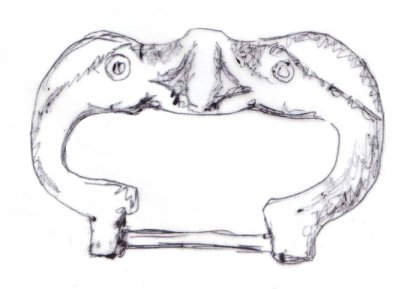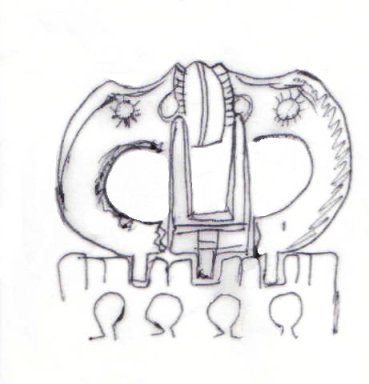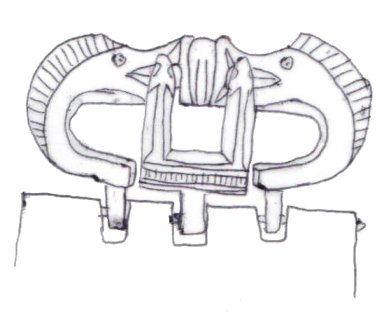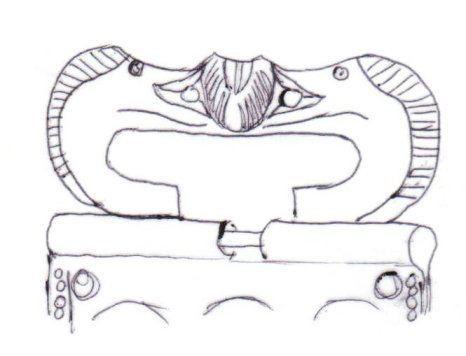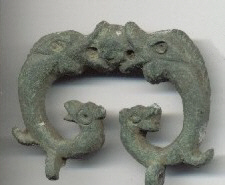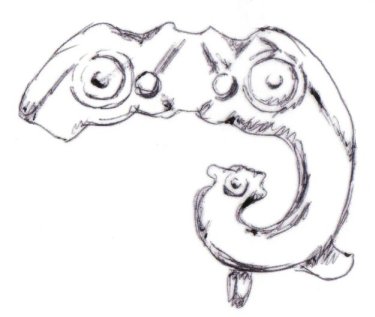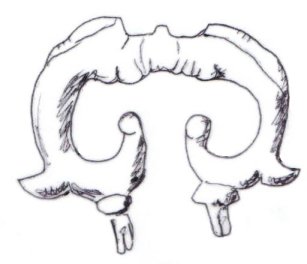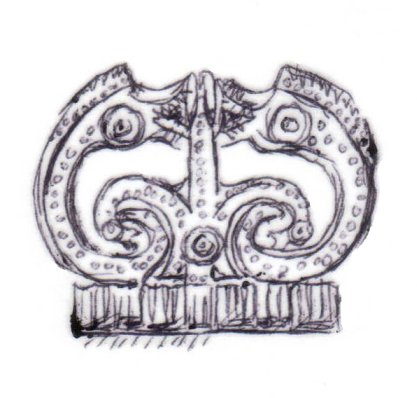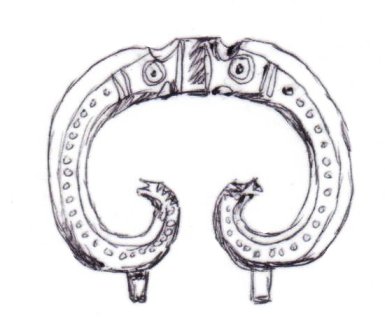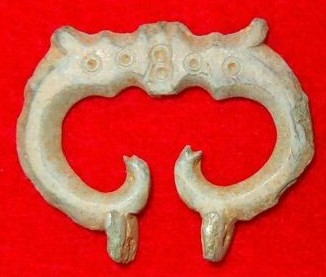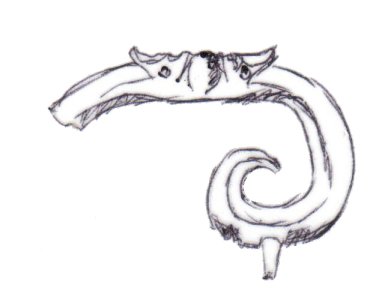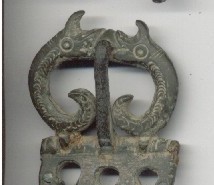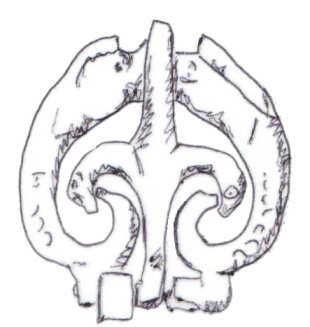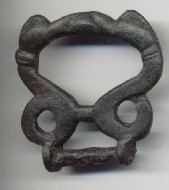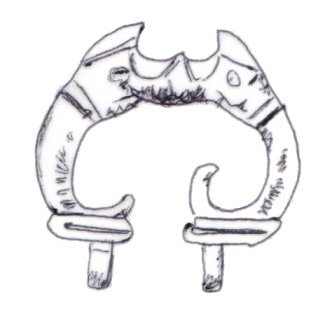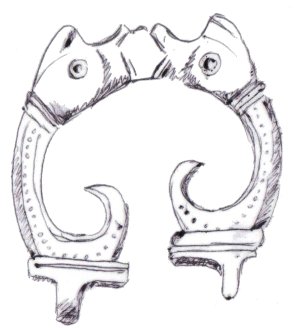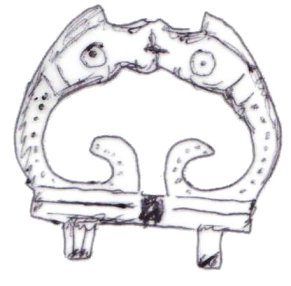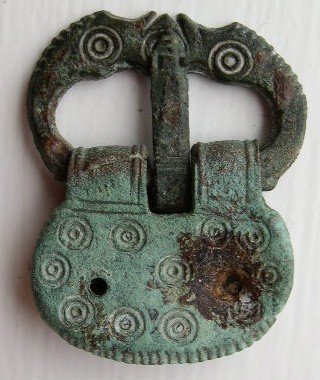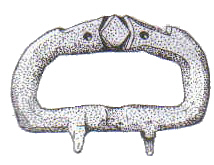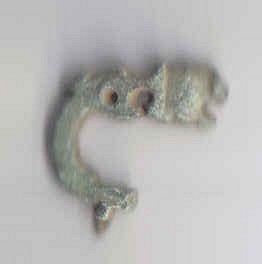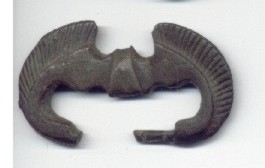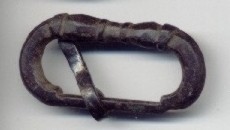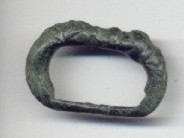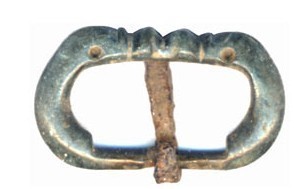title page
forward to bird
LATE ROMAN BUCKLES IN BRITAIN
1. - DOLPHIN
|
|
by Stuart Laycock and Chris Marshall
OPEN LOOP & FIXED PLATE
The zoomorphic buckle of late Roman and post Roman Britain start with the continental series of dolphin buckles. These appear in the first half of the 4th century and are found in a band along the borders of the empire. Why dolphins?? The dolphin is an ancient symbol in Greek and Roman art associated with Oceanus and his Roman counterpart Neptune. Dolphins can be seen on many artefacts from ceramic oil lamps through to mosaic floors as at Fishbourne. In metal-work two dolphins grasping a globe is a common form of furniture handle (1) and similar handles may also have been used on military helmets. Equipment for the Roman army was produced in provincial workshops where these symbols and patterns could be adapted to Roman tastes. Their origin may also lie in Roman military symbols.
The Notitia Dignitatum is a document that records among other things the shield symbols of Roman military units across the Empire. One large group among these designs shows twin headed symbols which are similar to the basic dolphin buckle design (2). The Notitia Dignitatum is probably of early 5th century date, but the Arch of Constantine, built in 315, shows a similar shield design, suggesting that if the shields and buckles are linked, the latter derive from the former rather than the other way round. Incidentally, a significant proportion of the units bearing the twin-headed symbols on their shields, have, judging by their names, links with north-west Europe, from where Constantine drew the army that fought with him at the Battle of the Milvian Bridge. It is possible, therefore, that the twin-headed symbol may have been originally linked specifically to Constantine and his dynasty
click on thumbnails for larger image
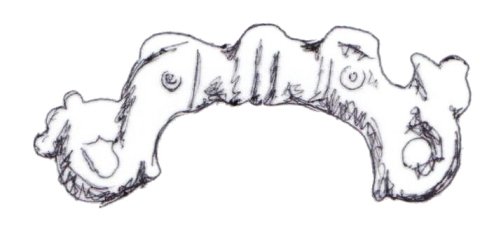 |
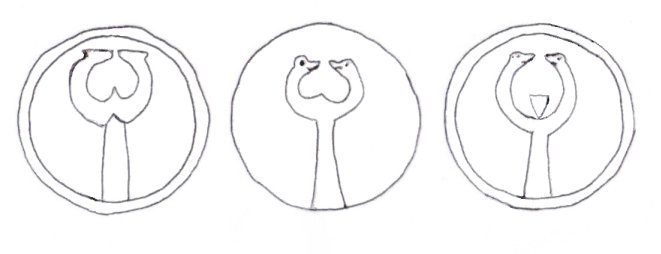 |
| LM 1.1 |
LM 1.2 |
CONTINENTAL TYPE FOUND IN BRITAIN - BROADHEAD OPEN LOOP DOLPHIN
The basic continental dolphin buckle type is, with minor variations, found across Europe (3, 4, 5). Two dolphins with big broad heads and low crests (or just occasionally no crests) hold a globe or egg shape in their mouths. Sometimes this oval shape is split vertically (6), which, (bearing in mind the sometimes rather phallic treatment of the buckle pin) is probably a female sexual reference. The dolphin bodies sweep round to form the open loop, ending in stubby terminals (or, just occasionally beast heads) with small attachment loops to fix the buckle to a, usually rectangular, buckle plate.
click on thumbnails for larger image
BRITISH TYPE - BROADHEAD OPEN LOOP DOLPHIN
The influence of this type, dominant on the continent, is clearly visible in British buckles, but from the start of the dolphin buckles? life in Britain stylistic variations develop and multiply. Versions of the broadhead dolphins appear with fixed plate (7) and with separate belt bar, for instance (8). Comparatively very few of the basic continental type have, however, been found. The Dorchester buckle (9) is one example and the Leicester (10) buckle may be another.
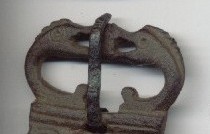 |
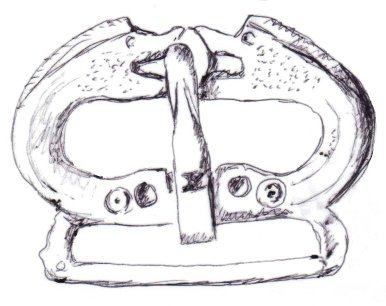 |
 |
 |
| LM 1.7 |
LM 1.8 |
LM 1.9 |
LM 1.10 |
The lack of the basic type in Britain, raises some interesting questions about the means of transmission of the style from continental Europe across the Channel. It has been suggested that the buckles were introduced by the Roman army that crossed to Britain to combat the so-called ?Barbarian Conspiracy? of 367. It is a reasonable suggestion, which with, the arrival of large numbers of troops, followed by their subsequent withdrawal with their kit shortly after, might suggest, why the dolphin type arose in Britain, but why there are so few of the continental prototypes found here.
Such a process might also help explain another curious aspect of British dolphin buckles. Some of their forms echo earlier 3rd century buckles (11, 12). The separate bar (8) is a feature apparently inherited from 3rd century buckles, as is the higher, more rounded shape of many British loops, and the curling inward of the terminals (13), and also the occasional appearance of a type where the tongue is fixed to a bar between the curling terminals (14). If a new style, dolphins, was suddenly introduced to an island used to buckle styles long obsolescent in mainland Europe these are exactly the kind of hybrid features one might expect. Once established in Britain, the basic dolphin type rapidly develops a spectacular range of regional and stylistic variations. The sheer diversity again raises some interesting questions.
click on thumbnails for larger image
 |
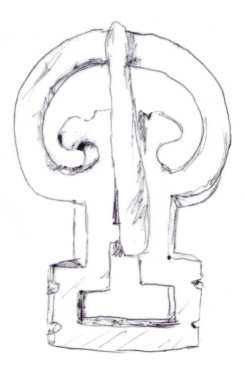 |
 |
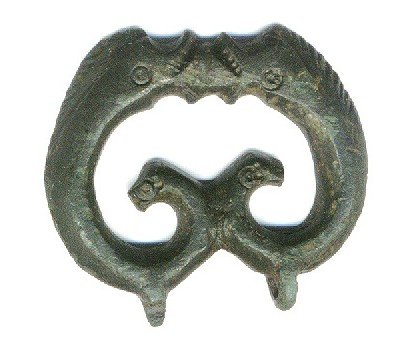 |
| LM 1.11 |
LM 1.12 |
LM 1.13 |
LM 1.14 |
The distribution of the dolphins buckle along the imperial borders in continental Europe makes it fairly clear that the buckles there have a primarily military function. Their stylistic diversity and distribution on civilian, as well as military sites across southern and eastern Britain have led some to suggest a civilian function for them in Britain but buckles are not worn by the civilian population prior to 300 AD, and there is no evidence for their adoption by civilians in the 4th century. It seems far more likely that what we are seeing with the buckles is the militarisation of the civilian population in the light of external threats like the ?Barbarian Conspiracy? and in response to Rome?s slackening grip on power in Britain, after 370AD.
Bearing all this in mind, the stylistic variations of British dolphin buckles are a fascinating potential source of information on the break-up of Roman Britain, or at the very least, can tell us some interesting things about communication between different parts of Britain in the last decades of Roman rule.
BRITISH OPEN LOOP BROADHEAD DOLPHIN TYPES
In the first, stylistic phase of development, relatively minor adaptations are made to the basic continental broadhead open loop buckle.
Fin
In these buckles (15, 16, 17) a little curling fin is attached to the outside of the loop, near the base. With only three examples available, it?s difficult to be sure, but this seems to be an east England variation, and (as discussed elsewhere) is probably the first stage of the stylistic mutation that leads to bird buckles. It is also probably the origin of the side loop buckles (see below).
click on thumbnails for larger image
Small Eastern Broadhead
This group looks stylistically quite like continental broadheads (18, 19, 20, 21), but they are much smaller, about half the size, and have a characteristic thin casting. They are based in Norfolk and Lincolnshire, and half the group show a small side loop (20, 21). This loop serves no obvious functional purpose and it seems most likely that it is a development of the small curled fins of the fin buckles (see above).
click on thumbnails for larger image
 |
 |
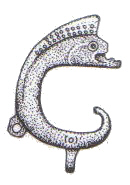 |
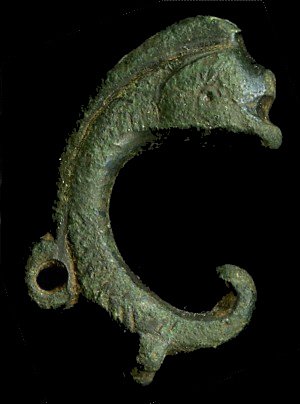 |
| LM 1.18 |
1.19 |
LM 1.20 |
LM 1.21 |
Norfolk Head
The Norfolk head buckles are stylistically very similar to the continental broadhead type, except that a rounded human head replaces the globe. For a more detailed treatment of this group, see the Head Buckle section (here).
Catuvellaunia Dots
The earliest of this group has strong affinities with the broadhead group, though they tend to feature the archaising upward curl of the terminals discussed earlier. However, their most distinctive feature is a line of dots along the ?bodies? of the dolphins (22, 23, 24). This is not without parallel elsewhere, but there does seem to be a concentration of this type, to the exclusion of many other types in the area of the Catuvallauni?s tribal lands. This raises the possibility that this group of buckles may have some link to the Catuvellauni, and perhaps even to a semi-independent or entirely independent Catuvallauni militia.
click on thumbnails for larger image
NO CREST OPEN LOOP DOLPHINS
In a subsequent stage of stylistic development, the broadhead dolphins themselves begin to change.
Serpent
In another stylistic development in eastern England, the dolphins lose their crests, acquire collars, and become almost serpent like (25, 26, 27). Such dolphin are occasionally encountered on continental buckles, so it is hard to be sure whether this is entirely a British development, but the upturned loops of the buckles, do at least indicate that these buckles are made in Britain. These eastern ?serpent? buckles with their collars may be the origin of some of the ?transitional types discussed in the Lion Buckle section.
click on thumbnails for larger image
Western Ears
A stylistic development taking place in western England at the same time is the appearance of ?ears? or possibly ?horns? on some dolphins (28, 29, 30).
click on thumbnails for larger image
HIGH CREST DOLPHINS
However, in many cases, rather than disappearing, the dolphins? crest seems to get shorter and higher, and the dolphins? heads get smaller (31, 32, 33).
click on thumbnails for larger image
North and East Dots
One particular group of this style is a type that appears just in the north and east of the country, and in addition to their distinctive small heads and high crests, the dolphins feature dot on their bodies , like the Catuvallauni dots group (34, 35, 36).
click on thumbnails for larger image
Fixed plate types
Alongside the open loop types with high crests and small heads, are a small number with fixed plates (37, 38, 39, 40). These seem to be concentrated again, in the east of the country, but one is said to have been found in Dorset (40), so with the small numbers available, it is hard to be sure whether this is a regional or national type.
click on thumbnails for larger image
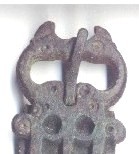 |
 |
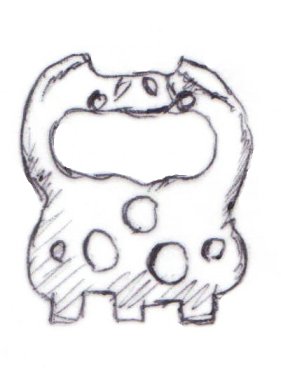 |
 |
| LM 1.37 |
LM 1.38 |
LM 1.39 |
LM 1.40 |
CLOSED LOOP
At some stage, alongside the open loop broadhead types, closed loop broadhead types appear on the continent, to be followed by other types of closed loop dolphin buckles. They appear mainly to be later than the open loop types, and stylistically there is far less consistency between continental closed loop types than there is with continental open loop types. This presumably represents a similar pattern of regional and stylistic fragmentation under the pressure of the political and military situation, to that seen in Britain.
It is hard to be certain about the way in which the closed loop types come about. They may simply be influenced by the large number of closed loop non-zoomorphic types circulating. Certainly, on the continent the closed loop types seem to replace the open loops types, although they are probably never in quite the same numbers.
In Britain, the situation with continental closed loop buckles is rather different to that with the open loop types. Perhaps the key is that, whereas open loops had been in use on the continent for some time before appearing in Britain, closed loop buckle development starts at roughly the same time in Britain as on the continent,. Whatever the reason, there are a higher proportion of continental, or close copies of continental closed loop buckles found in Britain.These closed loop buckles fall into three main categories:-
CONTINENTAL TYPES FOUND IN BRITAIN
Broadhead Closed Loop
This seems on the continent to be a north European development (41) and, appropriately enough, the one (42) or two British examples come from Eastern England.
click on thumbnails for larger image
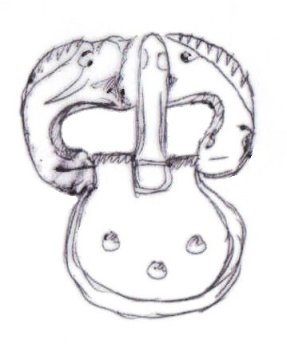 |
 |
| LM 1.41 |
LM 1.42 |
Big Eye closed loop
A number of examples of this type come from Eastern Europe (43, 44). In Britain one has been found at Lankhills, Winchester (45), an area that has produced other evidence suggesting the presence there, in late Roman times of East Europeans.
click on thumbnails for larger image
?No Crest? closed loop
These are found in a number of parts of eastern England (46, 47), as well along the imperial frontiers in Europe (48, 49).
click on thumbnails for larger image
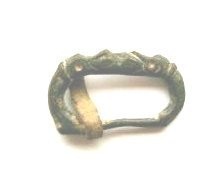 |
 |
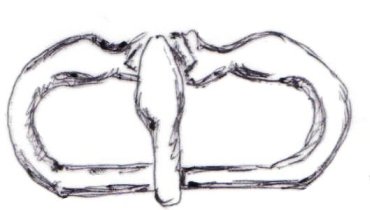 |
 |
| LM 1.46 |
LM 1.47 |
LM 1.48 |
LM 1.49 |
BRITISH TYPES
As with the open loop types, however, British closed loop buckle design also takes directions all of its own.
Closed loop with attachment loops
A small number of closed loop buckles, with attachment loops reminiscent of the open loop type, come from eastern England (50, 51, 52). These may be ?missing links? on the path of development between open loop and closed loop, or they may be stylistic hybrids.
click on thumbnails for larger image
Big Crest closed loop
These appear in the south and east of the country (53, 54, 55), the areas closest to the continent, and are not too distant from continental broadhead types. However, the style of manufacture indicates they are British buckles.
click on thumbnails for larger image
No Crest Transitional types
There are a series of presumably late zoomorphic buckles in Britain, where the animal shapes have becomes so undefined that it is impossible to tell whether they feature lions or dolphins (56, 57). Some, with a bulge where the mane would be, seem more likely to be lions. Some may well be derivatives of the continental ?no crest? dolphin type. The transitional buckles, in question, are, however, almost certainly British buckles. There are two continental parallels, but both of these are from Germany (58) and may well be British exports or British influenced. So far two groups of transitional types have been noted that may be dolphin related. One is in East Anglia and one is, further west in the Wiltshire region.
click on thumbnails for larger image
Horsehead Buckles
The most major British development in closed loop buckles is the horsehead buckles, which are dealt with in their own section (here).
Dolphin D Rings
A group of dolphin closed loop buckles appears which have developed the same D ring as the classic horsehead buckles (59, 60, 61, 62). It is possible that these represent a parallel development to the horshead D rings in which the earlier oblong dolphin closed loops became higher and more rounded. However, the small number of these dolphin D rings, as opposed to the large number of horsehead D Rings, suggests that, in fact, these dolphin D rings are more likely to be derivations of the horsehead buckles. This possibility is supported by the fact that the dolphins on the dolphin D-rings usually either have scales (59) (like so many of the horsehead buckles, and unlike most early closed loop dolphin buckle) or have almost disappeared into abstract shapes (60, 61) (again like so many of the horsehead buckles, and unlike most early closed loop dolphin buckle).
click on thumbnails for larger image
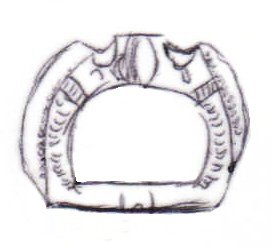 |
 |
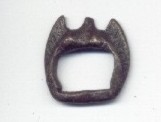 |
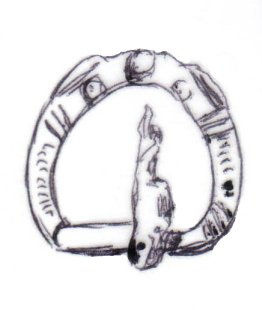 |
| LM 1.59 |
LM 1.60 |
LM 1.61 |
LM 1.62 |
In some cases, the horseheads have been replaced by extended dolphin crests (59, 60, 61), in some cases by nothing (62). If the dolphin D rings are derived from the horsehead D rings, it raises the question of why the horseheads have been removed. It may be a purely stylistic decision, or just possibly it might have political origins. As discussed in the horsehead section, there appears to be some connection the distribution of horsehead buckles and a range of late Roman or post-Roman linear earthworks which seem likely to demonstrate areas of political/military tension during the fragmentation of Roman Britain. In a number of areas the horsehead buckles are found in much larger numbers on one side of those earthworks, than on the other. This may simply be the result of trade interrupted by conflict, but it is also possible that the horseheads themselves could have become the symbol of a distinct political and military alliance. If so, the removal of the horseheads from buckles would be significant, and it is largely true, that dolphin D rings appear in different areas to horsehead buckles. The one main area, where this seems not to apply is Cirencester which has both horseheads and dolphin D rings. It is hard to tell what the significance of that is. Though, it does not necessarily destroy the argument that there are political differences between horeshead and non-horsehead areas. Cirencester, after all, could have moved from one political grouping to another at some stage.
Dolphin Triangular closed loops
This is a rare development in south central England (63, 64), and probably leads on from the dolphin D rings. In this type, the high arch of some of the D rings has become more pointed and eventually formed a triangle. Only two examples of this type are known. It is worth noting how the dolphins on buckle 63 are similar to those on some horsehead buckles - eg. (here)
click on thumbnails for larger image
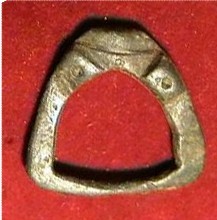 |
 |
| LM 1.63 |
LM 1.64 |
NOTES
1.1 Width not known, found not known, redrawn after eBay; 1.2 Redrawn after Barker; 1.3 Width 44mm, found mainland Europe, private collection; 1.4 Width 45mm, found Vermand, France, redrawn after Sommer; 1.5 Width 44mm, found Augst, Switzerland, redrawn after Sommer; 1.6 Width 44mm, found Vermand, France, redrawn after Sommer; 1.7 Width 39mm, found Somerford Keynes, Gloucs., collection of Brian Cavill; 1.8 Height 40mm, found Barnsley Park Roman Villa, Gloucs., redrawn after Cotswold.gov.uk; 1.9 Width not known, found Dorchester, Dorset, redrawn after Britannia 15; 1.10 Width 50mm (broken; estimated), found Leicester, redrawn after Hawkes & Dunning; 1.11 Width 67mm, found Signidunum, collection of Brian Cavill; 1.12 Width not known, found not known, private collection; 1.13 Width 32mm, Rackheath, north of Norwich, Norfolk, collection of Stuart Laycock; 1.14 Width not known, found near Colchester, Essex, private collection; 1.15 Width 42mm, found Kent, collection of Brian Cavill; 1.16 Width 43mm, found Leicestershire, private collection; 1.17 Width 39mm, found Lincoln, Lincs., redrawn after Hawkes (1); 1.18 Width 20mm, found Norfolk, collection of Stuart Laycock; 1.19 Width 30mm (broken; estimated), found Kirmington, Lincs., from Leahy (2); 1.20 Width 43mm (broken; estimated),, found Dragonby, Lincs., from Leahy (2); 1.21 Width not known, found Thornton Cleveleys, Lancs, TimeLine Originals; 1.22 Length 60mm, found Colchester, Essex, redrawn after Hawkes & Dunning; 1.23 Width 56mm, found Lakenheath, Suffolk, redrawn after Hawkes & Dunning; 1.24 Width 28mm, found St. Albans, Herts., redrawn after Hawkes & Dunning; 1.25 Width 40mm, found probably Yorkshire, collection of Stuart Laycock; 1.26 Width 44mm, found Mitcham, Surrey, redrawn after Hawkes & Dunning; 1.27 Width fragment; not known, found Caistor-by-Norwich, Norfolk, redrawn after Hawkes & Dunning; 1.28 Width 31mm, found probably Dorset, collection of Stuart Laycock; 1.29 Width 43mm (broken estimated), found Caerwent, Mons., redrawn after Hawkes & Dunning; 1.30 Width 34mm, found near Baydon, Wilts., collection of Brian Cavill; 1.31 Width 30mm, Lydney Park, Gloucs., redrawn after Hawkes & Dunning; 1.32 Width 32mm, found Wisbech, Cambs., formerly collection of Brian Cavill; 1.33 Width 28mm, found Lullingstone, Kent, redrawn after Hawkes & Dunning; 1.34 Width 34mm, found Langtoft nr Rudston, Yorks., private collection; 1.35 Width not known, found Stickford, Lincs., private collection; 1.36 Width 32mm, found Malton, Yorks., collection of Stuart Laycock; 1.37 Width 26mm, found not known, collection of Brian Cavill; 1.38 Width 27mm, found near Northampton, Northants, collection of Stuart Laycock; 1.39 Width 28mm, found Richborough, Kent, redrawn after Hawkes & Dunning; 1.40 Width 25mm, found Dorset, collection of Brian Cavill; 1.41 Width 38mm, found Vermand, France, redrawn after Sommer; 1.42 Width 32mm, found near Caistor St. Edmund, Norfolk, collection of Stuart Laycock; 1.43 Width 32mm, found Eastern Europe, private collection; 1.44 Width 31mm, found Eastern Europe, private collection; 1.45 Width 32mm, found Winchester, Hants., formerly collection of Brian Cavill; 1.46 Width 30mm, found Harston, Cambs., collection of Stuart Laycock; 1.47 Width 30mm, found possibly Norfolk, collection of Stuart Laycock; 1.48 Width 34mm, found Eastern Europe, private collection; 1.49 Width not known, found Sremska Mitrovica, Serbia, redrawn after eBay; 1.50 Width 38mm, found Osgodby, Lincs., from Leahy (2); 1.51 Width 19mm, found near Watton, Norfolk collection of Stuart Laycock; 1.52 Width 30mm, found Norfolk, collection of Stuart Laycock; 1.53 Width 34mm, found Beddingham Hill, Sussex, redrawn after Hawkes & Dunning; 1.54 Width 44mm, found Silchester, Hants, redrawn after Hawkes & Dunning; 1.55 Width 47mm, found Suffolk, formerly collection of Brian Cavill; 1.56 Width 40mm, found Latton near Cricklade, Wilts., collection of Brian Cavill; 1.57 Width 30mm, found Wanborough, Wilts, collection of Brian Cavill; 1.58 Width 41mm, found Germany, private collection; 1.59 Width 28mm, found Chichester, W. Sussex, redrawn after Hawkes & Dunning; 1.60 Length 75mm, found Cirencester, Gloucs., redrawn after Hawkes & Dunning; 1.61 Width 18mm, found Perrots Brook, north of Cirencester, Gloucs., formerly collection of Brian Cavill; 1.62 Width 30mm, found Blewburton Hill, Berks, redrawn after Hawkes & Dunning; 1.63 Width 19mm, found?, collection of Stuart Laycock; 1.64 Width 20mm, found Ogbourne Maizey, Wilts., collection of Brian Cavill.
REFERENCES
Barker P. - The Armies and Enemies of Imperial Rome (1981)
Britannia 15 (1984)
Hawkes S.C & Dunning G.C. - Soldiers & Settlers in Britain, Fourth to Fifth Century - Medieval Archaeology 5 (1961)
Hawkes S.C. (1) - Some recent finds of Late Roman Buckles - Britannia 5 (1974)
Leahy K.A. (2) - Late Roman and Early Germanic Metalwork from Lincolnshire - A Prospect of Lincolnshire (1985)
Sommer M. - Die G?rtel und G?rtelbeschl?ge des 4. und 5. Jahrhunderts im R?mischen Reich. (1984)
title page
forward to bird
|
Copyright © May 2005, Laycock & Marshall, All Rights Reserved.
| |




